
MAY CONTAIN NUTS

Search Shorpy
SHORPY ART

Framed or unframed, desk size to sofa size, printed by us in Arizona and Alabama since 2007. Explore now.
Join and Share
Ad-Free Shorpy
Shorpy is funded by you. Patreon contributors get an ad-free experience.
Learn more.

Recent comments
- Robie House Roof(s)
- There is an interesting novel set here.
- I Was In Berlin
- Pronunciation
- Shell of a Shell
- Never been there but
- BUR-lin
- Hand-made smokes
- Birthplace of Tupperware, or at least its inventor
- Pulp
- Remarkably unchanged in 84 years
- The church is still there ...
- Talk about a smoke show
- Electric Hansom Cab
- I wondered the same thing.
- The location in 2009
- Pill Pusher
- Roll your own
- Rugged and real!
- Civil War history
- Early EV?
- A Charles Purcell - Mama Cass Connection
- Uncle SAAM
- Obfuscation
- One Chocolate Soldier rode away
- Victor Marquis de la Roche
- The Little House Across Way ...
- Vanderbilt Gates
- Vanderbilt Mansion
- You can still see that gate
Member Photos
The Shorpy
Printporium
Printporium
Search Shorpy
Search results -- 30 results per page
- Beacon Beckons: 1902
- ... that. Fire in 1927 destroyed both the Casino and adjacent hotel. It brought an end to all development on the Mount.
Both gone A ...
The Casino and Beaconcrest Hotel burned to the ground on Oct 16, 1927, but a new resort was built the next ... were burned to the ground in fires in 1981 and 1983.
Hotel gone, rails still in place Last year I hiked up that mountain and ... Posted by Dave - 02/09/2019 - 2:33pm -
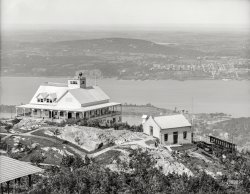
- Take a Letter: 1920
- ... sit up. Swelter time off the Potomac, it seems.
Hotel Awnings The awnings on the near right belong to the Willard Hotel and the ones on the building to the far right belong to the Washington ... Posted by Dave - 08/13/2013 - 3:56pm -
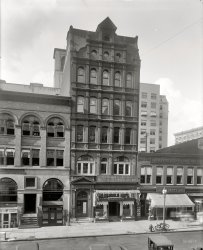
- White Shoe Diary: 1904
- ... posted earlier).
Anyhoo, follow the piazza into the hotel and head into the men's room just off to the left of the rotunda stairs. ... was a public entrance for the more carefree types.
The hotel is gone but the bar survives in a West Palm Beach restaurant.
Tea was ... Posted by Dave - 08/13/2012 - 9:12pm -
![White Shoe Diary: 1904 Florida circa 1904. "Afternoon concert hour. The Royal Poinciana, Palm Beach." We return to the RP for a bit of culture. And please, no velocipedes. 8x10 inch dry plate glass negative, Detroit Publishing Company. View full size.
'Dearest'Dearest Penelope,
I am so looking forward to seeing you Saturday for the concert. I will save you a seat.
Norbert
Where to get a real drinkThe band is playing at the end of a long piazza that extended out from the front entrance (it hadn't been added yet in the pic posted earlier).
Anyhoo, follow the piazza into the hotel and head into the men's room just off to the left of the rotunda stairs.
Inside you'll find a door that takes you into a long, hidden hallway leading to the men's bar. This was affectionately dubbed "Hypocrite's Row." There was a public entrance for the more carefree types.
The hotel is gone but the bar survives in a West Palm Beach restaurant.
Tea was what was normally served on the lawn.
Time travel!See, time travel is possible! Check out the lone lady on the far right. It looks like she has her notebook PC open and is blogging about her experience right now.
CONSiSTEnT TyPEFaCESnot allowed on this sign.
Smile for the man with the time machineThere's a guy over there from a hundred years in the future looking at us!
A leg upIt looks like they've attached boards to the chairs in a sledlike fashion so that they don't sink into the ground. Rather ingenious, actually. Someone should patent that design! It would make countless outdoor wedding receptions nicer.
Also, I've always thought that palm trees photographed in black and white almost always look foreboding. Definitely the case for me here. Something terrible is surely about to happen, possibly involving Norbert and the lone umbrella.
A few more years playing cello at the hoteland I can pick up a nice gig on the Titanic.
Chillin'Obviously our era does not hold the franchise on genteel living and the enjoyment of life. They look like they have it down pat.
[Where are the cocktails? - Dave]
Dear NorbertPer yours of the Twelfth inst.:
Bother not to save me a seat. I shan't occupy it. You are an obnoxious boor, a pompous windbag, and I forecast that four spinsters will adjoin your solitary table and heap scorn upon you.
I have had many wonderful times, but none with you. I have run off with Emile.
Penelope
Yes, time travel is possible!For a grandmother, like me, to sit and study photographs like this ("picture" doesn't seem adequate), taken before my own grandparents were born, is truly like taking a short trip in a time machine!
Thanks, Shorpy!
(The Gallery, DPC, Florida, Travel & Vacation)](https://www.shorpy.com/files/images/4a11865a.thumbnail.jpg)
- On the Avenue: 1905
- ... Below is the same view from April of 2006.
St. Regis hotel Lovely building, and luckily, still exists. As I see, they even built ... Posted by Dave - 12/28/2012 - 12:23pm -
![On the Avenue: 1905 New York circa 1905. "St. Regis and Gotham hotels." Looking south along Fifth Avenue at East 56th Street, a streetscape glimpsed here from a different angle. On the right, the Gotham rising behind Fifth Avenue Presbyterian Church. 8x10 inch dry plate glass negative, Detroit Publishing Company. View full size.
Vigilant copThe cop in the car across the street is eyeing us pretty good.
[He's a chauffeur. - tterrace]
+101Below is the same view from April of 2006.
St. Regis hotelLovely building, and luckily, still exists. As I see, they even built a "bigger" version in Atlanta (2009). Still prefer the original one!
Current viewThis is from Google Maps. Nice to see it's lasted nearly 100 years.
(The Gallery, Cars, Trucks, Buses, DPC, NYC)](https://www.shorpy.com/files/images/SHORPY_4a18646a.thumbnail.jpg)
- Market Street: 1926
- ... Market Street: 1904 And here it is pre-earthquake.
Hotel Terminal You can check out any time you like but you can never leave. ... next morning. Looking out the widows at the Hyatt Regency Hotel across the street might be interesting too - especially when a convention ... Posted by Dave - 11/09/2015 - 4:56pm -
![Market Street: 1926 San Francisco ca. 1926. "Market Street from Ferry Building." Note the backwards Owl Cigar signage. 8x10 nitrate negative, photographer unknown. View full size.
Foster and Kleiser billboardThe Maxwell House billboard bears the maker's name on top, Foster and Kleiser.
According to Wikipedia, that firm evolved into the current-day Clear Channel Outdoor Holdings, "the oldest outdoor advertising company in the United States as their roots trace back to the three companies that merged into the current incarnation: Foster & Kleiser (1901-1986), Patrick Media Outdoor (1986-1995) and Eller Media Company (1959-1997)."
Perfectly readable in the rearviewI bet that sign was designed for those people stuck waiting to turn into traffic off the side road. Anyone turning onto it would be past before seeing it, but if you're stuck waiting for traffic to clear and happen to glance in your mirrors it would be perfectly readable. How about an Owl?
[Generally speaking, 1920s cars did not have rearview mirrors, and the sign itself looks to be quite a bit older. Even in 1925, the majority of eyeballs passing by would have been on streetcars. While the sign might have reflected off the windows of the building across the street, I suspect eye-catching novelty was the strategy. - Dave]
19 Years EarlierThe same view taken while the City was still smoldering in 1906.
Spectral Christmas treeThere appears to be something swinging/spinning from the pole like a loose mast halyard in the right foreground, causing a Christmas tree-like artifact. Must have been a breezy day and a bright rope!
[The thing on the flagpole is the Stars and Stripes. There another one at the next street corner. - Dave]
Market Street: 1904And here it is pre-earthquake.
Hotel TerminalYou can check out any time you like but you can never leave.
Short cityNearly all of the low-rise buildings in that photo are gone now, wiped out between 1960-90. The Loma Prieta earthquake of 1989 was used as a feeble excuse for condemning the few remainders, including one in which I had been working just a couple years earlier. Fortunately, most of the vintage 10-12 storey buildings survive.
General OfficesThe building one block up on the left still stands. It was the headquarters of the Southern Pacific Railroad where I kept things running on Third Trick (midnights). My office was just past the balcony on the 6th floor facing Market Street. There was no need for air conditioning; you just opened the windows. We used the windows to get rid of stale coffee too - not too many pedestrians late at night. Being there the last working day of the year was interesting. Office workers had a strange habit of throwing small calendar pages (the kind that you flipped a page each day) out the windows before going home. It was almost like a ticker tape parade. A legion of street cleaners would have it all swept away by the next morning. Looking out the widows at the Hyatt Regency Hotel across the street might be interesting too - especially when a convention was in town.
Owl Cigars 5 cents M.A. Gunst & Co.Moses A. Gunst One of the most beloved men in the history of San Francisco.
http://www.jmaw.org/gunst-united-cigar-california/
One of My Faves From ShorpyThis is a great one! The guys painting the Maxwell House sign! Bernstein's Fish Grotto!
Why don't we name things "Grotto" anymore? Grottos had a good run but seemed to peter out by the 80's.
A truly historic photo This documents the last time there were parking spaces on Market Street in San Francisco.
Russ Building?Emporis says the Russ Building was finished 1927-- think that's it under construction, midway between 225 Bush and the Mark Hopkins?
[The building under construction is the Western Women's Club headquarters (a.k.a. "San Francisco Women's Club") at 609 Sutter. In the 1940s it became the Marines' Memorial Club and Hotel. - Dave]
(The Gallery, Cars, Trucks, Buses, San Francisco, Streetcars)](https://www.shorpy.com/files/images/SHORPY-755.thumbnail.jpg)
- The Ridgewood: 1904
- Daytona Beach, Florida, 1904. "Hotel Ridgewood, Ridgewood Avenue." The shady byway last glimpsed here , ...
Torn down, not burned down Amazingly enough, a hotel structure featured on Shorpy survived fires! Unfortunately, torn down in ... Posted by Dave - 02/18/2024 - 3:46pm -
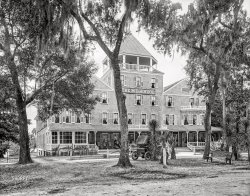
- High Time: 1904
- ... the same view from October of 2013.
Bellevue-Stratford Hotel The large "white" building on the left, at 200 S. Broad Street, is the brand new Bellevue-Stratford Hotel. It became the focus of national news 72 years later when Legionella ... Posted by Dave - 04/17/2018 - 5:18pm -
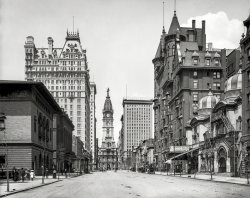
- Attention Honeymooners: 1939
- ... for some of a failed actor's furniture).
The Summit Hotel and John Gilbert's Bed From The National Road in Pennsylvania, ... Books) By Cassandra Vivian (Arcadia, 2003): The Summit Hotel
Caption from post card on page: Summit Hotel, Golf and Country Club, ... Posted by Dave - 02/14/2013 - 8:46am -
![Attention Honeymooners: 1939 From August 1939 comes this unlabeled negative, one of a series of pictures taken by Herbert Mayer in Virginia and Maine and residing in the Farm Security Administration archive at the Library of Congress, and its cryptic message. Honi soit qui mal y pense: Happy Valentine's Day from Shorpy! View full size.
No Thanks, Mr. GilbertI think if I was on my honeymoon I'd let Hollywood icon John Gilbert keep his bed while the missus and I got our own. Thanks for the offer though. And I do speak French and I do think evil of your offer.
News item: Aug. 26, 1936
An old saying."Evil be to him who evil thinks."
John GilbertAnother Rudolph Valentino-esque silent film star, John Gilbert died an alcoholic a few years before this photo was taken, but when the sign was painted he would have been one of the leading men of his era.
He was blacklisted by Louis Mayer after a fight between the two at Gilbert's (planned) double wedding, where he would have married Greta Garbo (who jilted him at the alter) while one of Mayer's leading directors, King Vidor, married his on bride, in what would have been a blockbuster event.
Sad tail of one of the early great romantic leads in Hollywood.
[The rest of him sounds sad, too. - Dave]
Into the WoodsIn the late 1940s, my parents, with me in tow, spent several Summer sojourns at the Summit. Being but a tad at the time, my recollections now are somewhat sparse -- mainly the nice lady who ran the gift shop and let me play (carefully) with some of the toys, my first taste of honeydew melon in the restaurant, some time in the swimming pool, finding the odd golf tee whilst rambling on the golf course. Oh, and attempting to ride the messenger's bike down the toboggan run. I'm sure my parents found other attractions to the place, though decency militates against my contemplating them. With the Internet, I could probably find out almost instantly what ever became of the place, but I prefer to remember it as it was then: a renowned haven for harried city dwellers (and apparently the repository for some of a failed actor's furniture).
The Summit Hotel and John Gilbert's BedFrom The National Road in Pennsylvania, pp. 54-55 (available in Google Books) By Cassandra Vivian (Arcadia, 2003): The Summit Hotel
Caption from post card on page: Summit Hotel, Golf and Country Club, (above the clouds) Uniontown, PA
"Sitting atop Chestnut Ridge (the south side), the Spanish mission-style of Mount Summit Inn was once famous as a honeymoon hotel (actor John Gilbert's bed is in its honeymoon suite). It was built in 1900 of native mountain stone to accommodate the tourists of the automobile era. The view is spectacular during all seasons of the year, and a huge veranda surrounds the hotel."
There are additional postcards and text in the adjoining pages.
A billboard so naughty... they had to say it in French.
They forgot to mentionHourly rates.
Mail PouchMail Pouch would paint your whole barn free in return for the ad space, not just part of it.
The bedHere's a postcard of the room.
[But steer clear of the Lupe Velez bathroom. - tterrace]
The photographerThe photographer was my great uncle. He owned a lumber company in Virginia, not sure how his photograph got into the archives.
Someone needs to relearnFrench because the direct translation of 'Honi soit qui mal y pense' is 'evil be to him who evil thinks' buuuut if it is actually Latin it's more along the lines of 'Evil is not welcome'. Side note... "honi" should be "Honni"
[It's archaic, not modern French, and appropriate for the historical context of the phrase. - tterrace]
(The Gallery, Valentine's Day)](https://www.shorpy.com/files/images/SHORPY_8b31619a1.thumbnail.jpg)
- Big Variety: 1941
- ... like ghost towns with a lot of parked cars.
Honeymoon Hotel My folks spent their extended Honeymoon in the Vale Hotel just a couple of years before this photo was taken. They were married on ... Posted by Dave - 04/08/2021 - 5:08pm -
![Big Variety: 1941 July 1941. "Main street of Vale, Oregon, on the Fourth of July. Vale is one of the shopping centers for farmers who live and work on the Vale-Owyhee irrigation project." Medium format acetate negative by Russell Lee for the Farm Security Administration. View full size.
LocationThis is actually one block west of Main Street, at the intersection of Court Street and A Street looking east down A Street toward the mountain slope.
[The principal thoroughfare of a town is the main street. Which may or may not be called Main Street. The main street of Vale is A Street. Don't even ask who's on First. - Dave]
However if Main Street is capitalized one can assume that that is the name of the street rather than just the "main street of the town".
[In our photo caption, it's not capitalized. - Dave]
Rough day at the Tavern?What happened to the awning in front of the Coca Cola soda fountain? Maybe the guy walking right in front of the car tried to swing from it after getting kicked out of the Town Tavern? Mr. Whitehat seems to be playing it safe by looking before crossing.
July 2015But probably not the Fourth of July, based upon the comparatively placid scene:
Color me!Boy howdy, this would be a great image to colorize! Somebody with more time and skills should take it on, even without any pretty girls in it!
De-EvolvementI look at street-scapes of the past and compared to most exact scenes of today all I can think of how devolved we have become.
The Main Streets used to look so vibrant with activity, signs, flags, stores, and well....life.
Today most places look like ghost towns with a lot of parked cars.
Honeymoon HotelMy folks spent their extended Honeymoon in the Vale Hotel just a couple of years before this photo was taken. They were married on New Years Day 1939 in Boise, and stayed in that hotel for two weeks or so while they waited for their permanent house to be available. They lived in Vale for 15 years.
(The Gallery, Cars, Trucks, Buses, July 4, Russell Lee, Small Towns)](https://www.shorpy.com/files/images/SHORPY-8c36614a.thumbnail.jpg)
- The Pearly Gates: 1941
- ... the shovel for cleaning up the lawn after our dog.)
Hotel California for Bovines You can check out any time you like
But you ... Posted by Dave - 06/08/2020 - 10:46am -
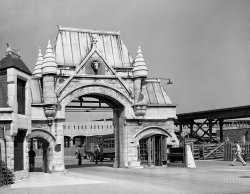
- Nebraska Noir: 1940
- ... View full size.
Another Picture from a Hotel Window It appears that Mr. Vachon took this picture from a room at the Capital Hotel (still standing, but now a YMCA). Below him is 11th Street. The Barker's ... Posted by Dave - 12/29/2019 - 3:15pm -
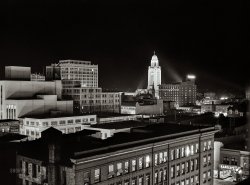
- Havana Harbor: 1904
- ... tons. There are plenty of private yachts that size.
Hotel Santander ? I think the Centro Balear (1885) is now the Hotel Santander on Luz Street in old Havana. The shipwreck is gone and the ... Posted by Dave - 09/08/2013 - 11:03am -
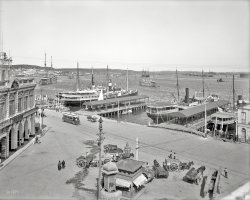
- Atlantic City Boardwalk: 1908
- Atlantic City, New Jersey, circa 1908. "Chalfonte Hotel and the Boardwalk." With some sort of spillage splotch in the middle, ... If the flag has 45 stars and the date is 1908, the hotel owner should have bought a new flag. Utah was the 45th state, admitted in ... Posted by Dave - 08/24/2011 - 1:14pm -
![Atlantic City Boardwalk: 1908 Atlantic City, New Jersey, circa 1908. "Chalfonte Hotel and the Boardwalk." With some sort of spillage splotch in the middle, "double chair" rental on the right and a 45-star flag topping it all off. Detroit Publishing glass negative. View full size.
Chair rental50 cents for the double chair rental seems like a lot in 1908. Unless that included one of the many men standing around to push you? Kind of like a rickshaw.
[Chair rental circa 1908 was 50 cents an hour. In 1913 the A.C. city commission, in a move to cut "chair congestion," passed an ordinance raising mercantile taxes on the chairs by $5 a year -- to $10 on single chairs, and $20 for double chairs. The commission's goal was a doubling of the rental rate to a dollar an hour. - Dave]
Sandy ClothesWow. I can't imagine how long it must have taken to get the sand out of those heavy wool clothes.
Double ChairsFrom a WPA guide to Atlantic City:
The next milestone in the history of the resort was the invention of the rolling chair in 1884. M.D. Shill, a Philadelphia manufacturer of invalid chairs, go-carts and perambulators, came to Atlantic City and opened a store to rent out baby carriages to summer families. He also rented out invalid chairs for convalescents and cripples. Within a few years these invalid chairs evolved into the double chair with a pusher. Triple chairs followed, completing the fleet of comfortable sightseeing chairs of today.
Tim-bers!Wow, those are some beautiful timbers stacked on the beach. Timbers like those would cost a fortune today.
TransitionsAtlantic City transitioned from this sedate scene to a bustling family-oriented seaside resort by the 1940s. I remember the Steel Pier and the Diving Horse. By the early '70s, A.C. hit rock bottom...then gambling was legalized. The rest (along with visitors' money) is history.
Tanning and HorsesLooking at all the clothes these people are wearing makes me realize that being tan probably wasn't as common, at least for city folk. There is hardly any skin showing on anyone.
Also, note the horses bottom left. I guess someone had the job of cleaning up after them on the beach/boardwalk.
Neat picture, btw. And I agree about the time machine, though I'd like a ticket back in case things didn't work out.
Wow...Can I go back in time please... One way is OK... Sign me up and get me outta here!
45 StarsIf the flag has 45 stars and the date is 1908, the hotel owner should have bought a new flag. Utah was the 45th state, admitted in 1896. Oklahoma was 46th, admitted in 1907.
[The 46-star flag was adopted July 4, 1908. If the photo was taken in 1908, it was probably before the Fourth of July. - Dave]
Ah yes, the old ChalfonteIn the early 1940's, while the tires were still mileage-viable on my dad's 1937 Chevy 2-door, we traveled to AC from Newburgh, NY, several times as a family. We usually bunked at the Chalfonte or its sister hotel down the block, Haddon Hall. As a kid my favorite place on the AC boardwalk was the James Salt Water Taffy shop. They sold pressed paper cartons of those filling-yankers in really neat-looking wire barrel shapes. For many years, I used one of these as a piggy bank.
Hotel lobbiesCirca 1926 Ethel Waters made a record called "Jersey Walk," about a girl who dances in the hotel lobbies "just to hear those bellhops yell... 'Shake 'em up kid, shake 'em up kid, shake 'em up lady...'"
Janet Klein and her Parlor Boys recorded it much more recently.
Postal PhotosI see that Palace Postal Photos are best. I assume that is a place you could go to get a souvenier photo made to mail to the folks back home. Got any of those in your bag Dave?
[Afraid not. - Dave]
The Chalfonte and The Haddon Hall down the blockThose were family favorites for mini-vacations from upstate New York, so long as the tires on my dad's '37 Chevvy two-door had viable treads. Best shop on the AC Boardwalk for me was the James' Salt Water Taffy shop a few blocks west of the Chalfonte. They packaged their product in a molded papier-mache carton in the shape and color of a white barrel. I used one of these for years as a kid for my spare pocket change.
Nap time!I like the man on the beach taking a siesta. What strikes me most about this picture is how lazy we've become in regard to architecture. Maybe a glass brick is easier to heat and cool as well as construct but dang, look at that beautiful building!
Shill Rolling ChairI recently purchased a Shill Rolling Chair that seats three people. The brass plate mounted on the front of the white wicker frame says the charge was 75 cents an hour for one person or $1 an hour for two or more. I am curious about the age of the rolling chair. Based on the price per hour, would you know the age of my chair?
(The Gallery, Atlantic City, DPC, Sports)](https://www.shorpy.com/files/images/4a25626u.thumbnail.jpg)
- Kentucky Akimbo: 1940
- ... ... my neck hurts looking at this pic.
The Kentucky Hotel Built at Fifth & West Walnut in 1925, 18 stories, converted to ... Posted by Dave - 04/01/2022 - 3:39pm -
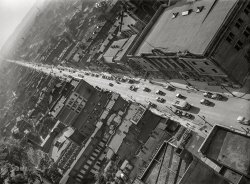
- Dinner on the Docks: 1910
- ...
Good Old Cowford! Judging by the location of the Hotel Seminole, this is the foot of Hogan Street. This location is now flanked ... of the first table is checking on his iPad?
Seminole Hotel The Seminole Hotel was brand new when this photo was taken, having ... Posted by Dave - 08/14/2012 - 8:49pm -
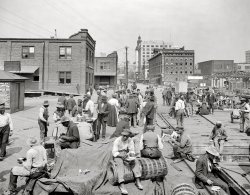
- Father Duffy: 1937
- ... there are a couple of surviving buildings. The Taft Hotel on the right is now an exclusive boutique hotel called The Michelangelo, while the building on the left with the Camel ... Posted by Dave - 07/27/2013 - 1:17pm -
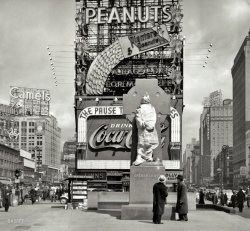
- The Big Hotels: 1910
- ... Company. View full size.
Get Out the "Hotel" Template "And they all burned down in _________ (fill in year)." ... Posted by Dave - 08/09/2012 - 7:15pm -
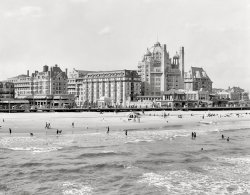
- A Captive Christmas: 1919
- ... or nice? I think I count five who are camera-shy.
Hotel on the Marsh
The old District Jail was on Reservation 13 , ... outside. It is not only to the masculine element of the "hotel on the marsh" the saint will pay his visit. That part of the institution ... Posted by Dave - 09/12/2011 - 10:48am -
![A Captive Christmas: 1919 December 1919. "Christmas tree at the District Jail, Washington, D.C., and some of the prisoners." National Photo Co. Collection glass negative. View full size.
Get a load of that!Did a blue two-headed dog walk by to the left of the camera man? What's everyone looking at over there?
Stocking Stuffers"Just what I wanted -- a hacksaw and a set of shivs!"
"Add Your Own Title"Was this a segregated jail or is that white guy hiding behind the tree the only white prisoner?
Not Too MerryThese guys seem camera-averse--and apparently were on the painting detail, judging from their clothing.
[That's mold on the emulsion. - Dave]
The Unbearable Sadness of Two-Story TreesThese unfortunate fellows should get together with those glum nurses from the hospital tree picture.
A Tree for ViewingI can't find an account of the 1919 Christmas, but here is one from the following year:
Christmas To Be Merry at Jail
Supt. Foster Plans Holiday Feast and Entertainment for Prisoners.
Though confined in narrow cells, many of them awaiting execution, prisoners at the District jail will not be forgotten tomorrow, when the people of Washington will be making merry in their homes, as an unusually attractive program has been arranged by superintendent Charles E. Foster, for the persons in his charge.
Religious services will be held in the morning following which the men will be given a regular Christmas breakfast, consisting of fruit and a variety of vegetables. The morning hours will be devoted to rest for the prisoners. Dinner will be served in the early afternoon. The menu is as follows: Roast pork with brown gravy, mashed potatoes, stewed turnips, creamed oyster plant, bread, butter and coffee and mince pie.
The Fort Myer band will play for the men in the afternoon and boxes of candy, furnished by the Gospel Mission, will be distributed. A huge tree decorated with colored balls and electric lights has been set up in the rotunda where the prisoners can view it.
Washington Post, Dec 24, 1920
District JailSo where was this? This is before Lorton?
Naughty or nice?I think I count five who are camera-shy.
Hotel on the Marsh
The old District Jail was on Reservation 13, southeast of the intersection of 19th and Independence SE. Today's jail, the Central Detention Facility, and its annex, the Correctional Treatment Facility, are a few blocks south.
UPDATE: Thanks to Dave for adding the above LOC photo of the old jail's exterior. On another note, at first reading, I had thought the following reference to the "arms of morpheus" to be indicative of the use of the drug morphine. However, on further research (i.e. Google), I find it turns out merely to be a traditional synonym for sleep.
Christmas Saint To Visit City Jail
Spirit of Season to be Carried to Inmates
Today in Varied Manner.
When the first peep of dawn threw the bars of the grated windows of the District jail in relief on the rotunda this morning, the personnel were abustle, and from every cell could be heard the ejaculations of prisoners who, going back to the days of childhood, peeped into the sock hung on the grate, to see what the jovial Kris had left in his flight over Washington.
For there are several chimneys at the jail down which the corpulent saint might have come with his bag, and it would be only a small matter to make his way through the several wings when the inmates were in the arms of morpheus and leave his tokens for those inside. Furthermore, the stockings had been provided.
The usual custom of keeping the inmates at the jail in the small and decidedly compact cells is taboo today for a few hours, and every man who, in the language of the gridiron, has "one month down and six to go," will have the opportunity to mingle with his neighbors and perhaps exchange a few gifts that do no exactly strike his fancy.
Every man and woman in the institution, from Death Row to the humble north wing, where the boys with sentences of ten to thirty days are lodged, will receive several presents today, all from Santa Claus institutions in Washington. Each man who will put his feet under the jail table at noon is assured a generous measure of candy and nuts and a sack of smoking or chewing tobacco.
Many of the men who receive socks and other articles of wearing apparel, and still others will be allowed to receive remembrances from friends on the outside. It is not only to the masculine element of the "hotel on the marsh" the saint will pay his visit. That part of the institution given over to the women who are spending Christmas as guests of the District will also be remembered.
In addition to the presents, many of which are sent to the jail anonymously, the inmates are going to get away from the regulation diet for the day, and a menu would do credit to a hotel where the guests pay for their accommodations have been prepared.
Dinner will be served at noon at the jail, following the religious services in the rotunda, when the 290 inmates will join the singing of Christmas carols and perhaps mingle in little groups for the discussion of current topics or the more important question of "how long before the stretch is up?"
After the recreation period, which will last several hours, the program, according to Supt. Peake, calls for dinner. The following menu has been prepared: Roast pork and mashed potatoes, and plenty of it; rich brown gravy, prepared by a cook from southern Maryland, in for a short stretch; celery, cranberries, bread, coffee and apple pie.
Presents in the guise of turkeys and "all the fixings" have reached the jail for individual "guests," but whether the inmates will be allowed to have their private dishes served up today has not been decided. After dinner the men and women will be returned to their regular wings, but will be permitted to mingle in the aisles during the afternoon and possibly up to 10 o'clock tonight, when the order of "lights out" is given.
A huge Christmas tree decorated in electric lights will be placed in the center of the rotunda of the jail, and each man and woman will receive at least one present from the gift pile following the service.
Despite the grumblings of a few who feel that a Christmas in a nice warm cell is undesirable, the vast majority of the prisoners, however, have expressed feelings of appreciation at all the preparations being made today for their welfare.
Washington Post, Dec 25, 1921
Behind the treeI find it odd that what appears to be the only white person is hiding behind the tree.
[Santa! - Dave]
(The Gallery, Christmas, D.C., Natl Photo)](https://www.shorpy.com/files/images/28552u.thumbnail.jpg)
- Laddies Who Launch: 1913
- ... Ship Building yard in Wyandotte. View full size.
HOTEL WINDOWS I've never noticed what appear to be large double hung windows ... Posted by Dave - 05/09/2019 - 1:32pm -
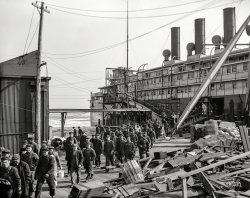
- Detroit: 1910
- Detroit, Michigan, circa 1910. "Hotel Pontchartrain and Campus Martius." Frequent photographic subjects of the ... It must have been a challenge trying to operate the tiny Hotel Metropole in the shadow of the giant Pontchartrain.
And what a ... of Elks (BPOE), which was hosted by the Pontchartrain Hotel.
(The Gallery, Detroit Photos, DPC, Streetcars) ... Posted by Dave - 12/02/2022 - 1:05pm -
![Detroit: 1910 Detroit, Michigan, circa 1910. "Hotel Pontchartrain and Campus Martius." Frequent photographic subjects of the Detroit Publishing Co. View full size.
Big BrotherIt must have been a challenge trying to operate the tiny Hotel Metropole in the shadow of the giant Pontchartrain.
And what a testament to the brand power of Coca-Cola. Ninety-five years later, that logo is so modern that it sticks out like a photobomb.
Times They Are A-ChangingIf you were to have taken this picture 5 years before the horses would outnumber the cars.
Who's Selling What??Love to know what "Misfit" is advertising.
["Misfit" seems to have been the retail category for what we would today call clothing seconds, or maybe something more like Big & Tall. There's another Misfit sign shown here, in New York, and here, in St. Louis. - Dave]
WildlifeI love the stag and deer statues. Those things are huge!
Misfits explainedBelieve it or not, people would have their pictures taken and not show up for the prints. Photogs would sell the orphan or - Misfits - pictures to recoup their losses.
The main market for these Misfts, were immigrant bachelors who wanted to send pictures of their sweeties back home, but they either didn't have sweeties, or they didn't have enough to have their pictures taken.
Hence, an immigrant bachelor who wanted to impress the family back in County Cork, or Berlin, would finger through the Misfit bins and pick out athe girl of their dreams.
[That's a colorful explanation but, as noted below, these are clothing stores. This particular Misfit was the haberdashery owned by Sol Berman (you can see BERMAN on the awning) at 120 Woodward Avenue in Detroit. Below, another Misfit Clothing Parlor in New York. - Dave]
Migrating Wildlife The "stag and deer" statue is actually of elk. It's one of several temporary monuments that were erected in Detroit for the 1910 national convention of the Benevolent and Protective Order of Elks (BPOE), which was hosted by the Pontchartrain Hotel.
(The Gallery, Detroit Photos, DPC, Streetcars)](https://www.shorpy.com/files/images/4a25864a.thumbnail.jpg)
- The Metropole: 1915
- Avalon, Calif., circa 1915. "Bathers at Hotel Metropole, Catalina Island." And yet another popcorn stand. 5x7 glass ... 4 a.m., a fire started mysteriously near the rear of the hotel. Avalon’s small fire department quickly was overwhelmed by the blaze, ... Posted by Dave - 07/08/2018 - 8:20pm -
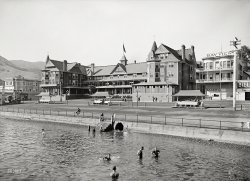
- Temple of Commerce: 1906
- ... is the same view from June of 2013.
The tower is now a hotel ...and accessible (sometimes)
... Posted by Dave - 02/25/2019 - 11:07am -
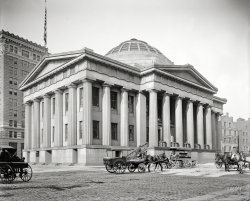
- Little Red MG: 1953
- ... Don Cox in a Tabasco-red MG at the Hotel Del Coronado in San Diego. Wanna race? View full size.
Kookie ... The Del Coronado was opened in 1888 as the then largest hotel in the world. Incredibly, it never burned down (the fate of so many of ... pairing of photos ( ignoring the Cadillac ).
The Hotel Del Coronado Mentioned below, in 1973 was used as the setting of a ... Posted by Dave - 02/21/2021 - 11:32pm -
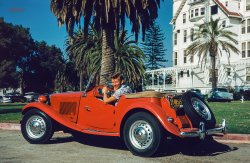
- Southern Accents: 1912
- Daytona Beach, Florida, circa 1910. "Hotel Ridgewood and Ridgewood Avenue." 8x10 inch dry plate glass negative, ... Posted by Dave - 02/18/2024 - 12:40am -
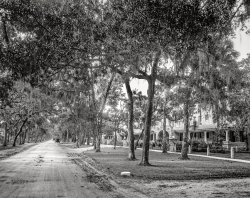
- Mabley and Carew: 1907
- ... A buzzing hive of commerce featuring a department store, hotel, jeweler, "dancing academy" and ice wagon. 8x10 inch dry plate glass ... their construction. The Sinton Block, which included the Hotel Sinton, was put up by the industrialist David Sinton. - Dave]
Every ... Posted by Dave - 08/12/2012 - 3:03pm -
![Mabley and Carew: 1907 Circa 1907. "Vine Street at Fifth, Cincinnati." A buzzing hive of commerce featuring a department store, hotel, jeweler, "dancing academy" and ice wagon. 8x10 inch dry plate glass negative, Detroit Publishing Company. View full size.
Massive pivot window sashesWindows on second floor of building to the right. Those upper-center pivoting sashes must be about six feet wide. Some of the project-out casements look large too. Wonder how such windows fared in really windy days? Love the fenestration technology/ styles used at the time.
Diamonds and TowersRichter and Phillips, a very upscale jeweler is still going strong in Cincinnati, and Joe Carew, of Mabley & Carew, did quite well for himself. Until recently the Carew Tower, which replaced the store, was the tallest structure in the Queen City at 49 stories. It is a beautiful Art Deco style building.
PerfectAll those windows on the top floor of the Mabley building and it is their stockroom for shoes, based on the size of the boxes you can see. Anyone know what the name "D. SINTON" on the building at the left refers to.
[The "block names" surmounting the era's business-district buildings are the people who financed their construction. The Sinton Block, which included the Hotel Sinton, was put up by the industrialist David Sinton. - Dave]
Every Kind of Hat For Every Needas long as you need a bowler.
But I guess that isn't much different from baseball hats, today.
Anti-Bovine ApparatusI guess in modern 1907 you still had the occasional stray
cow wandering around in the city. A factory option when you
purchased a new streetcar no doubt. On second thought, most of their close encounters of the cow kind probably happened when they reached the suburbs.
[Also those pedestrians who wouldn't moo-ve. - Dave]
From diamonds to drugsThis street has everything!
DetailsIt appears that the operator of trolley #16 is adjusting the switch he has to pass through before proceeding on his route. I always wondered how that was done.
The two pole system seems uncommon in most trolley photos. Our local transit company used to operate trolley buses with a dual pole system but when they ran streetcars they were single pole. Advantages to the dual wire system would probably include winter operations (unless the wires were coated with ice) but the downside would be that the cost of the system would increase as you'd need twice as much copper wire.
WonderingThis was my family's hometown at the time of the picture -- I wonder if any of the dapper folks on the street are my relatives. We have a lot of street-level snapshots of this area from the 1910s - 1940s.
The Hotel Sintonwas at 4th and Vine. Built 1907, demolished in 1967 - it was named after David Sinton. I lived in Cincinnati in the early 1960s and remember it as an empty hulk. Its claim to fame is that it was the site of the meeting which led to the Black Sox scandal of 1919.
Double Trolley Poles and CowcatchersThe city of Cincinnati required the trolley company to use the two wire collection/return system. Normally, trolleys used just one pole with the current to run the cars picked up from the wire and returned to the power station through the rails. Cincinnati officials feared that the current in the rails would induce corrosion in underground utilities (water, gas and sewer lines) and demanded the use of two wires to supply and return the current. The cars switched to one pole at the city limits.
The "cowcatcher" was a device to keep errant pedestrians from falling under the cars and being injured or killed by the underhung motors or the trolley's wheels. They were actually called "fenders". Some varieties automatically stopped the car if they hit an obstacle, providing the advantage of the car not derailing.
GroundedA single wire system requires a connection to ground to complete the circuit between the car and power plant. While saving copper costs, the system could damage metal fixtures in the ground as currents flowed through them (electrolysis) and rainy days might rob current from the "hot" overhead wire and shunt it directly to earth before it could be used by the car. Ground loops played havoc with such systems.
I read a story somewhere that when a single-wire system car got onto a section of track that had somehow lost its ground connection, a passenger stepping onto the car, completed the path to earth, and received a severe shock! I am sure that was rare.
(The Gallery, Cincinnati Photos, DPC, Stores & Markets, Streetcars)](https://www.shorpy.com/files/images/4a22285a.thumbnail.jpg)
- Retail White House: 1910
- ... Interesting info here .
Department Store Turned Hotel The ritzy anchor store of the Maison Blanche chain is now the ... Posted by Dave - 07/26/2016 - 3:33pm -
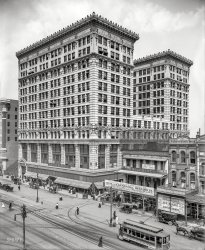
- Night and Fog: 1941
- ... think he might have known scenes like this as a kid.
Hotel Noir We'll leave a light on for you!
Almost nothing remains I ... Posted by Dave - 11/11/2018 - 10:46am -
![Night and Fog: 1941 January 1941. "New Bedford, Massachusetts. Street at night during a fog." Acetate negative by Jack Delano for the Farm Security Administration. View full size.
Have a nice trip?Those sidewalks must've been tough to navigate. The street seems safer. See ya next fall.
Time MachineIt's probably a good thing that time travel doesn't exist. I'd surely go broke paying to take a walk up and down streets like this and others found on Shorpy.
That SidewalkIs an insurance claim waiting to happen.
Tricky TitleAside from Wagner, Nacht und Nebel (Night and Fog) was a directive issued by Adolf Hitler on 7 December 1941 targeting political activists and resistance "helpers" in World War II to be imprisoned or killed, while the family and the population remained uncertain as to the fate or whereabouts of the Nazi state's alleged offender. Victims who disappeared in these "Night and Fog" actions were never heard from again.
[Best known as the title of Alan Resnais's immortal 1956 documentary. - Dave]
Nights like theseAre the kind that make you glad you're home by the fire.
Delano, on his game. Leaves you with the impression that the world existed in black and white.
Remarkable photographNew Bedford was where my grandfather ended up after arriving here from the Azores as a stowaway circa 1912. It's where my father was born. I've never visited and my father's family had moved to Brooklyn by 1941 but I'd like to think he might have known scenes like this as a kid.
Hotel NoirWe'll leave a light on for you!
Almost nothing remainsI located the Diana Lodge (198 Middle St.) on the left and the Clarendon House (197 Middle St.) in the 1939 city directory for New Bedford. It appears that the only remaining structure in the photo is the house that was once the Clarendon.
https://goo.gl/maps/GnacaQQD6Mr
(The Gallery, Jack Delano)](https://www.shorpy.com/files/images/SHORPY-8c04379a.thumbnail.jpg)
- Smoking Rubble: 1906
- ... the windows broke from the heat. When the quake struck the hotel was still two weeks from opening; the furnishings had been delivered but ... themselves off and went to work to rebuild the city.
Hotel Fairmont Looks like the hotel off in the distance. The outside of the ... Posted by Dave - 07/19/2012 - 4:39pm -
![Smoking Rubble: 1906 "Nob Hill from roof of Ferry Post Office." San Francisco after the earthquake and fire of April 18, 1906. Detroit Publishing glass negative. View full size.
GranddadMy grandfather (who died a year before I was born) claimed he was there for the earthquake, he was quite the wanderer in his early years. I wonder if he saw Caruso?
HighlanderThe Fairmont is still there. You can't see it from this distance but all of the windows broke from the heat. When the quake struck the hotel was still two weeks from opening; the furnishings had been delivered but not yet arranged, perhaps sparing the place from the fiery, utter destruction that the neighboring hotels met with.
She finally opened a year to the day after the quake.
Whittell BuildingAbout one quarter away from the left in the distance is the skeleton of a building with a low-peaked roof. It's not an earthquake victim, but the Whittell Building, under construction at the time. Local architects actually designed it to be seismically resistant; construction was completed and it stands to this day on Union Square. My Uncle Frank had his lapidary business in it from the 1920s until he retired. I remember riding up to it in the rickety cage elevator, and the gnarled old guy who operated it.
San FranciscoSan Francisco is such a fascinating city to me because as I rode the cable cars up and down its steep hilly streets, I wondered, "Who in the world thought this was a good place to build a city?"
I simply couldn't imagine being one of the first to enter this land and thinking it was a good idea to build a house and neighborhood on a street with a 60 degree incline. Surely they could have gone out just a bit farther and found flatter land.
Add to it this earthquake, and I marvel that they didn't just throw up their hands and find flatter land to settle in.
Glad they didn't though; SF is a gem among gems.
[Like most coastal cities, SF is where it is because of maritime geography, not topography -- an anchorage at the mouth of a sheltered bay. - Dave]
Rubble rubble everywhereVast quantities of rubble were dumped along San Francisco's bay shore from Fisherman's Wharf to south of today's AT&T baseball park. The motive power? Mules, horses, and trains that ran on tracks laid temporarily atop city streets especially for the purpose. (According to the Library of Congress, nearly 17,000 horses were worked to death in the process. No stats for the poor mules.)
Historians agree, though, that little if any earthquake rubble was dumped in the modern Marina District. The reason? The undeveloped area (then called Harbor View) was too far from the destroyed downtown areas being cleared to be useful. Also, the intervening hills between downtown and Harbor View prohibiting laying railroad track.
Shaky FoundationsI have read that the Marina District which was heavily damaged in the last quake was built on fill from this quake. Kind of ironic when you think about it.
Re: Too MuchIt is a good thing everyone did not feel such despair. They got up, dusted themselves off and went to work to rebuild the city.
Hotel Fairmont Looks like the hotel off in the distance. The outside of the building survived relatively unscathed, but the interior suffered fire damage.
This is one of the most interesting images of the aftermath I've seen. I get a real sense of what it must have been like to see and be amongst the destruction. So much to clean up before the rebuilding begins.
Caruso's Last StandAnd after being awakened by the tremor, Caruso vowed never to return to San Francisco, a vow which he kept. As for the Fairmont Hotel, it was nearly complete at the time of the earthquake and fire, and its opening was delayed until the next year.
At the far left is another landmark of the time, the Call-Spreckels Building, home of the San Francisco Call newspaper.
Awful DamageWith every one of these I see on Shorpy, all I can think of is Hiroshima or Berlin circa 1945. Did you know that Enrico Caruso was in town at the time?
Too muchWhere and how do you even begin to clean up the debris? It's all just so overwhelming.
London on FriscoJack London on the quake:
Day was trying to dawn through the smoke-pall. A sickly light was creeping over the face of things. Once only the sun broke through the smoke-pall, blood-red, and showing quarter its usual size. The smoke-pall itself, viewed from beneath, was a rose color that pulsed and fluttered with lavender shades Then it turned to mauve and yellow and dun. There was no sun. And so dawned the second day on stricken San Francisco.
(The Gallery, DPC, Fires, Floods etc., San Francisco)](https://www.shorpy.com/files/images/4a13263a.thumbnail.jpg)
- American Splendor: 1955
- March 30, 1955. "Fontainebleau Hotel, Miami Beach. General view of lobby. Morris Lapidus, architect." ... like a Cary Grant or a Grace Kelly while they were in this hotel. To transport them to someplace 'special' and well removed from their ... Posted by Dave - 01/22/2014 - 10:05am -
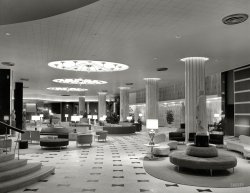
- What This Country Needs: 1906
- ... 1920, the KC Times building had been replaced with the Kay Hotel and it was that building that eventually fell to urban renewal in the ... the red light district. Quick, call Lewis Hine!
Kay Hotel demolished ... in 1954, according to the Kansas City Public Library, ... Posted by Dave - 08/20/2012 - 10:49am -
![What This Country Needs: 1906 Kansas City, Missouri, circa 1906. "Junction of Main and Delaware Streets." 8x10 inch dry plate glass negative, Detroit Publishing Company. View full size.
A Good Five-Cent CigarOf course, only to hold off the chill of what appears to be a frosty day!
Old city streetsI love these old street scenes you select. My grandfather who was born in 1880's had lots of old sayings that meant little to us grandkids. One was "it's everywhere like horseshit." These old photos almost always include somebody sweeping it up. Now I know what he meant.
The Junction.This intersection (9th and Main) was known as "The Junction." As you might have guessed from the signs.
That's the Kansas City Times newspaper building in the middle, with the spire thing on top, even though railroad ticket offices were on the first floor and someone put that "Junction Building" sign on it.
By 1920, the KC Times building had been replaced with the Kay Hotel and it was that building that eventually fell to urban renewal in the 60s.
[Note the faint T on the roof of the Times tower. - Dave]
Vertiginous EgressThat cast iron spiral fire escape on the building with the beehive dome was probably thought safe enough at the time, but, after only a few moments of imagining using it in an emergency, I'm all ready for a nice lie-down in a dark room.
Wells Fargo, and lunch to goWells Fargo wagon to the left (Express!) and the fellow with the apron across the street selling sandwiches from the looks of it (it IS 25 past 1, after all!)
ManvilleI looked over this carefully and I can't see any women at all, out shopping or on the street! It truly was a man's world.
Long gone.I-70 would eventually pass a couple of blocks in the distance and all these buildings were gone by then to make way for urban renewal and ramps down to the interstate. Everything probably went down by 1960 or so.
Kansas City has its share of remaining historic buildings but all the buildings in this photo are long gone.
The Commerce (Bank) Tower is currently on the corner (9th and Main) just beyond Palace Clothing. It went up in 1965 as the area was redeveloped into parking lots, parking garages and your typical 60s era highrises.
My mother was working near this location in the early 1950s and she was still using the streetcars (the more modern versions) then. Streetcar service ended by 1957.
Everything's up to date in Kansas City"They gone about as fer as they can go
They went an' built a skyscraper seven stories high
About as high as a buildin' orta grow."
Horses back thenHad a lot to watch out for, didn't they?
Downward SpiralIn about the middle of the photo, towards the back, there seems to be a spiral staircase fire escape. I don't believe I have ever seen one like this.
Ladies of the AfternoonWhat I continue to find amazing are the lack of women in these downtown type pictures. I see only two in front of the Junction ticket office.
R.R. ticket officesThe Chicago & Alton, Missouri Pacific, Santa Fe, Milwaukee Road, Wabash, and a joint office of the Frisco and, I think, the Rock Island.
Nothing left?A tour up Delware to Main on Google Street view shows that there is nothing of this scene left except for the names of the thoroughfares. It's all a flat expanse of 4- and 6-lane asphalt, empty lots. and what look like low-rise warehouses. Automobiles roam, supreme in the environment.
This gives me hope. Perhaps in another century, the auto will be as rare on our city streets as the horse is today.
What this commenter needsA Stetson hat and five-cent cigar make for a winning combination.
MessengerThere's a messenger boy on the lower right, no doubt hurrying to the red light district. Quick, call Lewis Hine!
Kay Hotel demolished... in 1954, according to the Kansas City Public Library, which has a few more pictures of this intersection in its images archives.
Dave, I love Shorpy!
IncredibleThe detail on the lamp standards, fire hydrants &c is wonderful. I'm terribly curious about what appears to be a pedestrian bridge in the background -- does anyone know what it might have connected?
(The Gallery, DPC, Kansas City, Stores & Markets, Streetcars)](https://www.shorpy.com/files/images/4a13233a.thumbnail.jpg)























